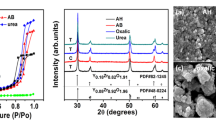Abstract
Ultrafine, PbZr0.53Ti0.47O3 powder was synthesized by homogeneous precipitation of metal ions in aqueous solution using urea. The results obtained from different characterization methods were compared with those obtained from the conventional precipitation method using ammonia in terms of crystallization, homogeneity, and microstructure. The as-dried precipitate converted to the single-phase crystalline lead zirconate titanate powder when calcined at 550 °C and above. The calcined powder showed smaller particle size, minimum agglomeration, and uniform shape. The growth of the particles was very little at higher temperatures. Powdered samples that precipitated using urea crystallized directly to rhombohedral lead zirconate titanate, without any intermediate pyrochlore phase formation. The NH3-precipitated powder converted to rhombohedral lead zirconate titanate via metastable pyrochlore and it showed phase segregation upon annealing at higher temperatures. The reaction kinetics has been studied by x-ray diffraction, differential thermal analysis, and differential scanning calorimetry.
Similar content being viewed by others
References
A.J. Moulson, J.M. Herbert: Electroceramics: Materials, Properties, Applications (Chapman & Hall, London, UK, 1990).
B. Jaffe, W.R. Cook, H. Jaffe: Piezoelectric Ceramics (Academic Press, New York, 1971).
A. Wu, P.M. Vilarinh, I.M. Salvado Miranda, J.L. Baptista: Sol-gel preparation of lead zirconate titanate powder and ceramics: Effect of alkoxide stablizers and lead precursor. J. Am. Ceram. Soc. 83(6), 1379 (2000).
M. Zang, I.M. Salvado Miranda, P.M. Vilarinh: Synthesis and characterization of lead zirconate titanate fibres prepared by sol-gel method: The role of acid. J. Am. Ceram. Soc. 86(5), 775 (2003).
D.E. Lakeman, D.A. Payne: Processing effects in the sol-gel preparation of PZT derived gel powders and ferroelectric thin layers. J. Am. Ceram. Soc. 75(11), 3091 (2003).
R. Zimmermann-Chopin, S. Auer: Spray drying of sol-gel precursors for the manufacturing of PZT powders. J. Sol-Gel Sci. Technol. 3, 101 (1994).
H. Chen, J. Ma, B. Jhu, Y. Cui: Reaction mechanisms in the formation of lead zirconate titanate solid solutions under hydrothermal conditions. J. Am. Ceram. Soc. 76(3), 625 (1993).
J. Moon, J.A. Kerchner, H. Krarup, J.H. Adair: Hydrothermal synthesis of ferroelectric perovskites from chemically modified titanium isopropoxide and acetate salts. J. Mater. Res. 14(2), 425 (1999).
X. Junmin, J. Wang: Lead zirconate titanate via reaction sintering of hydroxide precursors. J. Mater. Res. 14(4), 1503 (1999).
J. Scheafer, W. Sigmund, S. Roy, F. Aldinger: Low-temperature synthesis of ultrafine Pb(Z,rTi)O3 powder. J. Mater. Res. 12(10), 2518 (1997).
D.S. Seo, H. Kim, H.C. Jung, J.K. Lee: Synthesis and characterization of TiO2 nanocrystalline powder prepared by homogeneous precipitation using urea. J. Mater. Res. 18(3), 571 (2003).
T. Hwang, D.K. Hwang: Preparation of nanocrystalline lead zirconate powder by homogeneous precipitation using hydrogen peroxide and urea. Mater. Lett. 57, 2472 (2003).
E.E. Oren, E. Taspinar, A. Tas Cuneyt: Preparation of lead zirconate by homogeneous precipitation and calcination. J. Am. Ceram. Soc. 80(10), 2714 (1997).
S. Sohna, Y. Kwonb, Y. Kimc, D. Kimd: Synthesis and characterization of near-monodisperse yttria particles by homogeneous precipitation method. Powder Technol. 142, 136 (2004).
A.P. Oliveira, M.L. Torem: The influence of precipitation variables on zirconia powder synthesis. Powder Technol. 119, 181 (2001).
A. Tas Cüneyt: Preparation of lead zirconate titanate by homogeneous precipitation and calcination. J. Am. Ceram. Soc. 82(6), 1582 (1999).
J.P.S. Powder Diffraction File, Card Nos. 28-0529, 41-0677, 72-1144, and 75-0991.
B. Aiken, W.P. Hsu, E. Matijevic: Preparation and properties of monodispersed colloidal particles of lanthanide compounds: III, yttrium (III) and mixed yttrium(III)/ cerium(III) systems. J. Am. Ceram. Soc. 71(10), 845 (1988).
W.R. Schwartz, D.A. Payne Crystallization behavior of chemically prepared and rapidly solidified PbTiO3, in Better Ceramics Through Chemistry III, edited by C.J. Brinker, D.E. Clark, and D.R. Ulrich (Mater. Res. Soc. Symp. Proc. 121, Pittsburgh, PA, 1988), p. 199.
K.C. Chen, A. Janah, J.D. Mackenzie Crystallization of oxide films derived from metallo-organic precursors, in Better Ceramics Through Chemistry II, edited by C.J. Brinker, D.E. Clark, and D.R. Ulrich (Mater. Res. Soc. Symp. Proc. 73, Pittsburgh, PA, 1986), p. 731.
Author information
Authors and Affiliations
Corresponding author
Rights and permissions
About this article
Cite this article
Roy, S., Bysakh, S. & Subrahmanyam, J. Crystallization kinetics of homogeneously precipitated lead zirconate titanate using urea: Comparison with the conventional ammonia precipitated sample. Journal of Materials Research 21, 856–863 (2006). https://doi.org/10.1557/jmr.2006.0122
Received:
Accepted:
Published:
Issue Date:
DOI: https://doi.org/10.1557/jmr.2006.0122




